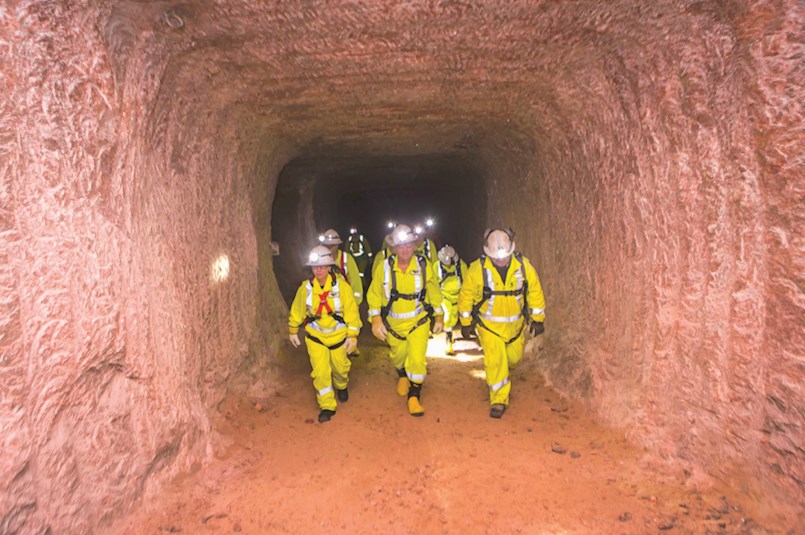February 16, 2017 — a date that signifies one of the biggest moments in Mosaic’s potash history.
On this day a year ago, we hit the potash level at our new mine in Esterhazy, Saskatchewan. While the journey started in March 2013, the concept and approval for the project began four years earlier.
Although hard to see without heading 3,350 feet under the surface, Mosaic’s state-of-the-art mine is progressing at a rapid pace, with significant work completed in the past year, both down below and above.
After hitting potash in February, work continued to join the two shafts, directionally named the North and South shafts. Late on May 2, we broke through the connection drift between the two, allowing for flow-through ventilation that can accommodate the diesel-run equipment required for underground development.
This milestone happened to occur the night before our stakeholder celebration held in Esterhazy to recognize the “next 50 years” of potash thanks to the K3 project. Members of our Senior Leadership Team were some of the first to have the opportunity to come down the South shaft, walk the 450 feet between, and come back up the North.
By June, the team completed the North shaft potash level station and permanent underground pump station excavations. Further work helped complete the bench for the main shaft steel hitch pedestals and the loading pocket excavation. Once in, the sinking of the North shaft continued.
July 1 brought the completion of the South shaft potash station including the equipment assembly bay and temporary electrical substation excavation. This work allowed us to prepare for the establishment of permanent power underground to transition from only drilling and blasting to mechanical excavation.
Next came the shaft feeder cables and smaller mine communication and grounding cables in September and October. Over in the North shaft, crews completed the installation of the main mine dewatering line.
By October 13, another big milestone took place – we turned on the lights underground, lighting the way for our K3 team to complete a feat that was a first for a Saskatchewan mine.
“We lowered a fully assembled drum miner chassis, weighing 127,000 lbs. or 60 tons (approximately the weight of 30 family size cars). Typically equipment of this size is assembled underground and taken down piece by piece,” says Director of Capital Expansion, Lawrence Berthelet.
“We safely completed this task by using two of the Galloway winch ropes. Other parts of the miner were lowered down and later put together, cutting down assembly time from 28 days to just four,” he adds.
The new drum miner was busy cutting by mid-November. Three more three-drum miners will be lowered in 2018.
A temporary loading pocket (or lip pocket) in the South shaft is currently allowing us to load sinking buckets from a measuring flask. We are now hoisting around 800 tons of potash per day with the lip pocket and transporting the development ore to our existing K1 mill.
While we are currently moving our K3 ore by truck, soon we will have our K3 to K2 overland conveyance system complete. To date, the conveyor project has achieved 475,000 man-hours with no recordable injuries.
Both the structural and mechanical construction of the transfer houses and the conveyors themselves are substantially complete. Near the end of 2017, the pulling and splicing of the conveyor belting were done. Commissioning will begin this May, and the system is expected to be fully operational in the fall.
A second conveyor is planned to run from the new K3 mine to K1. We held a community open house in September to share our plans for this second conveyor with local stakeholders. The required approvals and permits are being submitted to start construction activities this year.
With the ramp up of the K3 project resulting in ceasing underground mining operations at K1 and K2 to move to the new mine, significant transition planning is underway, both for product and people. Both sites’ surface operations are preparing to receive and process K3 ore.
“Over the next seven years, our Esterhazy operations will transform into the largest and one of the most competitive underground potash mines in the world – capable of moving 21 million short tons of potash ore per year from one of the best ore deposits,” says Vice President, Capital and Engineering, Potash – Gerry Couture.
While the project moves forward in 2018, environment, health, and safety performance will continue to be at the forefront.
“Achieving these significant milestones is very important to us, but what’s most important is that we do it safely. On a busy site, with many different contractors and complex work, safety is always the top priority,” adds Couture.
The project has logged over six million hours and has a 1.08 recordable incident frequency rate to date.
For more on the project, visit http://www.mosaicco.com/products/esterhazy_k3.htm.
— Submitted story & photos




